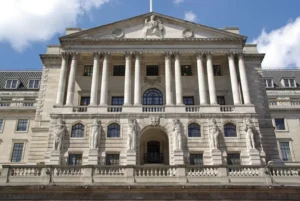
LONDON — Anticipation surrounds the Bank of England’s upcoming decision on Thursday, with widespread expectations for the central bank to maintain interest rates at 5.25%. While the market strongly favors a stance of no change, analysts are keenly monitoring voting patterns, forecasts, and language in search of indications regarding potential future rate cuts.
As of Wednesday afternoon, the market indicates a more than 96% probability that the Monetary Policy Committee of the British central bank will keep rates stable, considering recent economic data showcasing substantial progress across the institution’s three inflation persistence indicators.
Although the labor market displays signs of rebalancing, its overall trajectory remains somewhat uncertain. Notably, wage growth and services inflation have significantly diverged from the bank’s November projections, presenting a downside surprise, according to observations by Goldman Sachs economists last Sunday.
“We, therefore, anticipate a unanimous 9-0-0 vote with no dissents. However, predicting the vote split remains challenging due to limited recent commentary from MPC members,” remarked Goldman economist Ibrahim Quadri. He suggested that the three dissenting voices calling for further rate increases at the December meeting are likely to align in agreement this time.
In the event of dissents, Quadri proposed the possibility of a dovish dissent, with Swati Dhingra potentially voting for a 25bp cut, or a hawkish dissent, with Catherine Mann favoring a 25bp hike. However, the likelihood of hawkish dissents is considered lower, given the observed moderation in underlying services inflation since the MPC’s last meeting.
The annual rate of the services consumer price index recorded a modest increase, reaching 6.4% in December, slightly up from November’s 6.3%, but below the 6.9% observed in September. This data, the latest available to the Monetary Policy Committee (MPC) during its November projections, provides insights into the inflation landscape.
In an unexpected turn, the headline inflation for the U.K. experienced an upward shift, reaching an annual rate of 4% in December. This increase was attributed to a surge in alcohol and tobacco prices. Meanwhile, the closely monitored core Consumer Price Index (CPI) figure remained steady at 5.1%.
Despite a somewhat sluggish performance, the U.K. economy has surpassed expectations, managing to avoid a technical recession thus far. However, with GDP stagnating in the third quarter of 2023, concerns persist among many economists who foresee the possibility of an impending recession.
Updated projections
Quadri suggests that the revised projections on Thursday are likely to reveal a substantial upward adjustment in the bank’s growth forecast, coupled with a reduction in its near-term inflation forecast. However, he notes that there might be a revision upward towards the end of the forecast horizon due to a lower conditioning rate path.
“We anticipate the MPC to adhere to its data-dependent approach and reiterate the necessity for monetary policy to be sufficiently restrictive for a significant duration,” Quadri stated. He further suggests that the MPC might moderate its tightening bias and adopt a softer policy language, no longer asserting that “further tightening in monetary policy would be required if there were evidence of more persistent inflationary pressures.”
According to Goldman’s projections, they foresee an initial 25 basis point cut in May, followed by subsequent quarter-point increments at each meeting until the bank rate reaches 3% in May 2025.
JPMorgan’s U.K. economist, Allan Monks, anticipates that the Monetary Policy Committee (MPC) will hint at a potential easing of monetary policy around the summer, with a possible cut not materializing until August.
According to Monks, the Bank of England (BoE) is unlikely to rule out a potential cut in May but is also cautious about encouraging expectations for an early easing. In a research note last week, he stated, “The BoE’s updated narrative is likely to be that clear progress is being made on inflation, but that it is too early to declare victory and therefore caution must be exercised when thinking about when and how quickly policy can be normalized.”
JPMorgan predicts that the votes for further rate increases will disappear, resulting in a unanimous MPC decision to hold rates on Thursday. The bank did not rule out the possibility of Swati Dhingra voting for a 25 basis point cut at this meeting.
Monks emphasized that while the MPC’s vote is not formal guidance, changes in the vote from one meeting to the next often carry significant weight. He cautioned against interpreting a single dovish dissent as a reliable indicator of the entire committee’s stance or the likelihood of an earlier cut.

















































